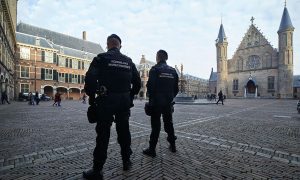A man wearing gloves on a summer’s day or a traveller at Amsterdam Airport Schiphol who is only interested in the security set-up. Details that go unnoticed to many people, but that are key to predictive profiling: recognising unusual or odd behaviour, a subject the Royal Netherlands Marechaussee (RNLM) is increasingly focusing on. Predictive profiling is now an integral part of the initial training programme and the aim is for every unit to eventually be assigned their own predictive profiling expert.
Since the end of last year, a new training plan for this topic has been in force at the Royal Netherlands Marechaussee Centre for Training and Expertise, meaning that eventually all operators will have undergone the same training programme.
Levels 1, 2 and 3
There are 3 levels in predictive profiling. From now on, all new RNLM colleagues will be trained in predictive profiling level 1 (pp1). After a series of lessons during the initial training programme and an e-learning module, they will receive their certificate. This means that everyone will be ready for their task when joining a brigade. Subsequently, practical situations will provide on-the-job training for those trained at pp1 level for their task in the brigade.
At this point, a colleague trained at pp2 level is also involved as a supervisor. This supervisor will coach the colleague trained at pp1 level. What actually is the standard, which was arrived at on the basis of experience and intelligence, and what deviates from this standard? Those trained at pp2 level will know how to answer this question. For example, an officer at pp1 level notices stress and recognises this as odd or unusual behaviour; however, at places such as airports, stress is quite normal. And a border guard at pp1 level may not immediately be alarmed if he sees a car with only a driver, while someone trained at pp2 level knows: this could be a scout.
In the near future, the RNLM will also have personnel trained at predictive profiling level 3. These are the experts; pp3 is a training programme at higher professional education level that was set up together with higher education institutes. Colleagues trained at pp3 level will provide the brigade commanders with advice. Using intelligence, they will identify risks and analyse threats. In this way, they can ‘predict’ unusual or odd behaviour. Ideally, every unit would ultimately be assigned their own officer trained at pp3 level.
The same approach
In addition, in future each RNLM domain will have to use the same working method in the area of predictive profiling. Predictive profiling is already standard within the security domain, and especially within the High Risk Security Unit, DH Security and the Special Security Missions Brigade. The RNLM has a five-member Behaviour Detection core team, and one of the things they will develop over the coming 5 years is an RNLM-wide approach to predictive profiling. The colleagues from the security domain have paved the way in this respect. They have their own, successful approach that was also used in preparing the new RNLM training plan. The challenge now lies with the border police task and the international and military police tasks domains in particular.
RNLM-wide
Why does the idea of predictive profiling need to be implemented RNLM-wide? Because someone intending to commit a criminal offence goes through several phases, from the preparation to the actual offence. Each phase comes with its own type of behaviour. Once this behaviour can be recognised and interpreted, incidents can be prevented. If each brigade operates on the basis of the same predictive profiling method with regard to the different phases in the criminal and terrorist planning cycle, there is a bigger chance of stopping a criminal or terrorist before an incident actually occurs.
A good example is a terrorist leaving Amsterdam Airport Schiphol with the objective of blowing up an aircraft. At Schiphol Plaza, he will first pass armed security and he may pass colleagues from teams in plain clothes. He will then go through passport control and in the aircraft he may be faced with an air marshall. These are personnel from different brigades. If they are all using the same working method, they will recognise which phase a suspect is in at a particular moment. This increases the chance of an early intervention.


